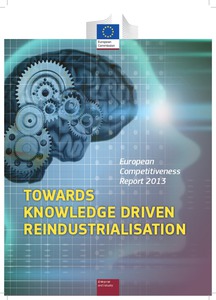European competitiveness report 2013. Towards knowledge-driven reindustrialisation
"Although the weight of manufacturing in the EU economy is decreasing in favour of services, manufacturing is increasingly seen as a pivotal sector. However, critical mass in the form of a minimum production base is needed. Industrial policy supporting innovation and external competitiveness ca...
| Institution: | ETUI-European Trade Union Institute |
|---|---|
| Format: | TEXT |
| Language: | English |
| Published: |
Luxembourg
2013
Publications Office of the European Union |
| Subjects: | |
| Online Access: | https://www.labourline.org/KENTIKA-19110860124919380429-european-competitiveness-repor.htm |
| Summary: | "Although the weight of manufacturing in the EU economy is decreasing in favour of services, manufacturing is increasingly seen as a pivotal sector. However, critical mass in the form of a minimum production base is needed. Industrial policy supporting innovation and external competitiveness can play a role to reverse the declining trend. To this end, EU industrial policy needs to steer structural change towards higher productivity in manufacturing and better positioning of EU enterprises in the global value chain based on comparative advantages in knowledge and technology intensive products and services. This is a must and a challenge for two reasons. First, the EU is lagging behind in productivity gains relative to emerging industrial powerhouses and some of its major competitors. The EU-US productivity gap, for instance, is growing wider again after years of narrowing. It is linked to a production efficiency gap caused by regulations, lower investment in ICT and intangible assets. In some sectors there is also a ‘commercialisation of research gap’ between the EU and the US. Policies targeting not only creation of new technologies, but also knowledge diffusion through measures to stimulate the supply of skills on the one hand, and demand for R&D on the other can help bridge such gaps. Second, structural change is slow, path-dependent and needs to build on existing strengths, but can be stimulated by having the right institutional framework in place, covering education, research, technology and innovation policies but focusing also on the general quality of governance. On the positive side, the report documents that the existing strengths of EU manufacturing are substantial. The revealed comparative advantage of EU manufacturing is linked to complex and high-quality product segments. By gradually increasing the complexity of their products, EU manufacturing industries managed to maintain their competitive position in 2009 compared with 1995. Moreover, EU manufactured exports have less embedded foreign value added than exports by third countries such as China, South Korea, Japan and USA. The EU is a major producer of new knowledge in key enabling technologies. Its products based on industrial biotechnology or advanced materials have higher technology content than competing North American or East Asian products. Apart from advanced manufacturing technologies, EU products based on key enabling technologies are mature and need to compete on price. Adding more innovative and complex products to the product portfolio will help manufacturers move up the value chain" |
|---|---|
| Physical Description: | 203 p. Digital |

